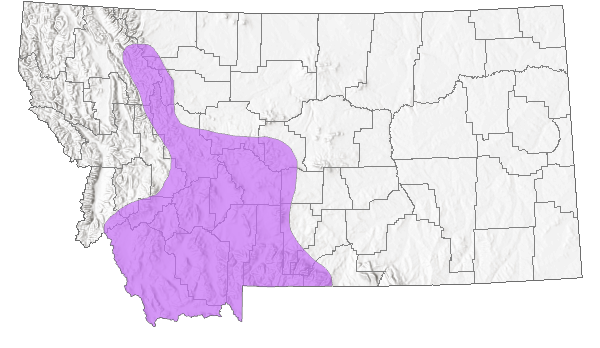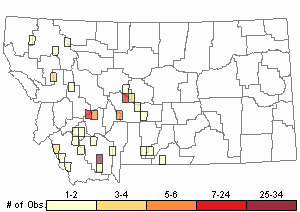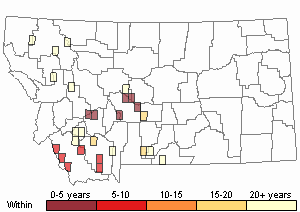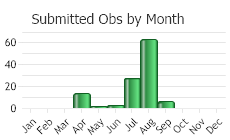View in other NatureServe Network Field Guides
NatureServe
Montana
Utah
Wyoming
Idaho
Wisconsin
British Columbia
South Carolina
Yukon
California
New York
Hall's Rush - Juncus hallii
Native Species
Global Rank:
G4G5
State Rank:
S4
(see State Rank Reason below)
C-value:
6
Agency Status
USFWS:
USFS:
BLM:
External Links
State Rank Reason (see State Rank above)
Rare, though widespread across the mountainous portions of southwest and central Montana. Threats and potential negative impacts to most known occurrences appear to be minimal and the species is likely tolerant of some levels of disturbance.
- Details on Status Ranking and Review
Population Size
Score1 - Moderate: Generally 10,000-100,000 individuals.
CommentPopulation size likely >10,000 individuals.
Range Extent
Score1 - Peripheral, Disjunct or Sporadic Distribution in MT: Widespread species that is peripheral, disjunct or sporadically distributed within MT such that it occurs in <5% of the state (<7,500 sq. miles or the combined area of Beaverhead and Ravalli Counties) or is restricted to 4-5 sub-basins.
CommentSparsely distributed in Montana and the Rocky Mountains.
Area of Occupancy
Score1 - Moderate: Generally occurring in 11-25 Subwatersheds (6th Code HUC’s).
CommentPopulations documented from 12 subwatersheds in southwest and central Montana.
Environmental Specificity
Score1 - Moderate: Species is restricted to a specific habitat that is more widely distributed or to several restricted habitats and is typically dependent upon relatively unaltered, good-quality habitat (C Values of 5-7).
CommentNot restricted to a rare or specialized habitat, though moderately reliant on good-condition habitat.
Trends
ScoreNA - Rank factor not assessed.
CommentTrends are likely stable, though monitoring data are lacking. Habitat extent and quality appear to be stable.
Threats
Score0-1 - Low to Medium.
CommentThreats to the species appear to be minimal and species appears to be tolerant of some level of disturbance.
Intrinsic Vulnerability
Score0 - Low Vulnerability: Species does not have any unusual or specific life history or biological attributes or limted reproductive potential which makes it susceptible to extirpation from stochastic events or other adverse impacts to its habitat and thus slow to recover.
Raw Conservation Status Score
Score
4 to 5 total points scored out of a possible 16 (Rarity factors and threats only).
General Description
Short-rhizomatous, caespitose. Stems erect, terete, 10–40 cm, tufted. Leaves mainly basal, bladeless; the 1 or 2 cauline leaves have terete blades 1 mm or less wide; auricles minute. Inflorescence congested with 2 to 7 subsessile flowers; lowest bract, terete, erect or ascending, shorter or longer than the inflorescence. Flowers with prophylls; tepals brown, 3–5 mm long, acute; stamens 6. Capsules 4–6 mm long, indented on top; seeds appendaged (
Lesica et al. 2012. Manual of Montana Vascular Plants. BRIT Press. Fort Worth, TX).
Phenology
Flowering from July-August.
Diagnostic Characteristics
Juncus is a large and difficult genus to distinguish, so a technical key should be consulted. Mature fruit is necessary for positive determination. The apparently lateral inflorescence, lack of an upper leaf blade, lobed seed capsule, and tailed seeds should help distinguish this species.
Species Range
Montana Range
Range Descriptions

 Native
Native
Range Comments
WA to MT south to UT and WY (Lesica et al. 2012. Manual of Montana Vascular Plants. BRIT Press. Fort Worth, TX).
Observations in Montana Natural Heritage Program Database
Number of Observations: 119
(Click on the following maps and charts to see full sized version)
Map Help and Descriptions
Relative Density

Recency



 (Observations spanning multiple months or years are excluded from time charts)
(Observations spanning multiple months or years are excluded from time charts)
Habitat
Subalpine parklands and moist meadows and slopes in the montane zone.
National Vegetation Classification System Groups Associated with this Species
Forest and Woodland
Montane - Subalpine Forest and Woodland
Grassland
Montane - Subalpine Grassland
Stewardship Responsibility
References
- Literature Cited AboveLegend:
 View Online Publication
View Online Publication Lesica, P., M.T. Lavin, and P.F. Stickney. 2012. Manual of Montana Vascular Plants. Fort Worth, TX: BRIT Press. viii + 771 p.
Lesica, P., M.T. Lavin, and P.F. Stickney. 2012. Manual of Montana Vascular Plants. Fort Worth, TX: BRIT Press. viii + 771 p.
- Additional ReferencesLegend:
 View Online Publication
View Online Publication
Do you know of a citation we're missing? Culver, D.R. 1994. Floristic analysis of the Centennial Region, Montana. M.Sc. Thesis. Montana State University, Bozeman. 199 pp.
Culver, D.R. 1994. Floristic analysis of the Centennial Region, Montana. M.Sc. Thesis. Montana State University, Bozeman. 199 pp. Hermann, F.J. 1975. Manual of the rushes (Juncus spp.) of the Rocky Mountains and Colorado basin. U.S. Forest Service, General Technical Report RM-18.
Hermann, F.J. 1975. Manual of the rushes (Juncus spp.) of the Rocky Mountains and Colorado basin. U.S. Forest Service, General Technical Report RM-18. Lesica, P. 1992. Vascular plant and sensitive plant species inventory for the Highland Mountains, Deerlodge National Forest. Unpublished report prepared for the Deerlodge National Forest. Montana Natural Heritage Program, Helena, MT. 21 pp. plus appendices, photographs.
Lesica, P. 1992. Vascular plant and sensitive plant species inventory for the Highland Mountains, Deerlodge National Forest. Unpublished report prepared for the Deerlodge National Forest. Montana Natural Heritage Program, Helena, MT. 21 pp. plus appendices, photographs. Lesica, P., M.T. Lavin, and P.F. Stickney. 2022. Manual of Montana Vascular Plants, Second Edition. Fort Worth, TX: BRIT Press. viii + 779 p.
Lesica, P., M.T. Lavin, and P.F. Stickney. 2022. Manual of Montana Vascular Plants, Second Edition. Fort Worth, TX: BRIT Press. viii + 779 p. Poole, J.M. and B.L. Heidel. 1993. Sensitive plant surveys in the Big Belt and Elkhorn Mountains, Helena National Forest, Montana. Unpublished report to the Helena National Forest. Montana Natural Heritage Program. Helena, MT. 129 pp. plus printouts, maps.
Poole, J.M. and B.L. Heidel. 1993. Sensitive plant surveys in the Big Belt and Elkhorn Mountains, Helena National Forest, Montana. Unpublished report to the Helena National Forest. Montana Natural Heritage Program. Helena, MT. 129 pp. plus printouts, maps. Welsh, S.L, N.D. Atwood, S. Goodrich, and L.C. Higgins. 1993. A Utah Flora. 2nd edition, revised. Provo, UT: Brigham Young University. 986 p.
Welsh, S.L, N.D. Atwood, S. Goodrich, and L.C. Higgins. 1993. A Utah Flora. 2nd edition, revised. Provo, UT: Brigham Young University. 986 p.
- Web Search Engines for Articles on "Hall's Rush"





